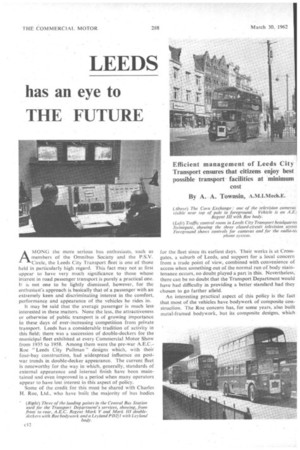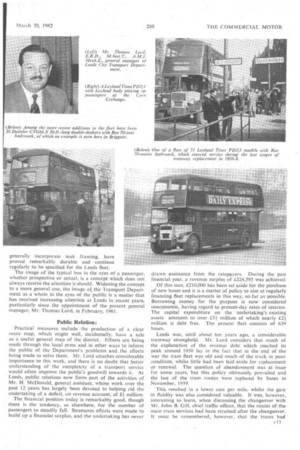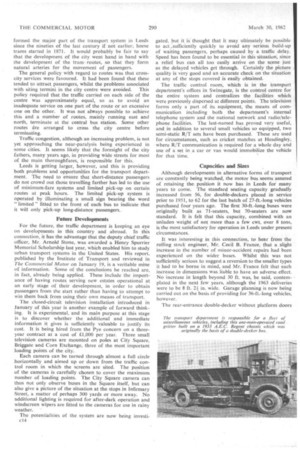LEEDS
Page 52

Page 53

Page 54

Page 55

If you've noticed an error in this article please click here to report it so we can fix it.
has an eye to THE FUTURE
AMONG the more serious bus enthusiasts, such as members of the Omnibus Society and the P.S.V. Circle, the Leeds City Transport fleet is one of those held in particularly high regard. This fact may not at first appear to have very much significance to those whose interest in road passenger transport is purely a practical one. II is not one to be lightly dismissed, however, for the enthusiast's approach is basically that of a passenger with an extremely keen and discriminating interest in the comfort. performance and appearance of the vehicles he rides in.
It may be said that the average passenger is much less interested in these matters. None the less, the attractiveness or otherwise of public transport is of growing importance in these days of ever-increasing competition from private transport. Leeds has a considerable tradition of activity in this field; there was a succession of double-deckers for the municipal fleet exhibited at every Commercial Motor Show from 1935 to 1958. Among them were the pre-war A.E.C.Roe " Leeds City Pullman" designs which, with their four-bay construction, had widespread influence on postwar trends in double-decker appearance. The current fleet is noteworthy for the way in which, generally, standards of external appearance and internal finish have been main tained and even improved in a period when many operators appear to have lost interest in this aspect of policy.
Some of the credit for this must be shared with Charles 14. Roe, Ltd.. who have built the majority of bus bodies for the fleet since its earliest days. Their works is at Crossgates, a suburb of Leeds, and support for a local concern from a trade point of view, combined with convenience of access when something out of the normal run of body maintenance occurs, no doubt played a part in this. Nevertheless, there can be no doubt that the Transport Department would have had difficulty in providing a better standard had they chosen to go farther afield.
An interesting practical aspect of this policy is the fact that most of the vehicles have bodywork of composite construction. The Roe concern has, for some years, also built metal-framed bodywork, but its composite designs. which generally incorporate teak framing, have proved remarkably durable and continue regularly to be specified for the Leeds fleet.
The image of the typical bus in the eyes of a passenger, whether prospective or actual, is a concept which does not always receive the attention it should. Widening the concept to a more general one, the image of the Transport Department as a whole in the eyes of the public is a matter that has received increasing attention at Leeds in recent years, particularly since the appointment of the present general manager, Mr. Thomas Lord, in February, 1961.
Public Relation; Practical measures include the production of a clear route map, which might well, incidentally, have a sale as a useful general map of the district. Efforts are being made through the local press and in other ways to inform the public of the Department's problems and the efforts being made to solve them. Mr. Lord attaches considerable importance to this work, and there is no doubt that better understanding of the complexity of a transport service would often improve the public's goodwill towards it. At Leeds, public relations now form part of the activities of Mr. H. McDonald, general assistant, whose work over the past 12 years has largely been devoted to helping rid the undertaking of a deficit, on revenue account, of £1 million.
The financial position today is remarkably good, though there is the tendency, as elsewhere, for the number of passengers to steadily fall. Strenuous efforts were made to build up a financial surplus, and the undertaking has never drawn assistance from the ratepayers. During the past financial year, a revenue surplus of 1224,595 was achieved.
Of this sum, £210,000 has been set aside for the purchase of new buses and it is a Matter of policy to aim at regularly financing fleet replacements in this way, so.far as possible. Borrowing money for the purpose is now considered uneconomic, having regard to present-day rates of interest. The capital expenditure on the undertaking's existing assets amounts to over £31 million of which nearly £24 million is debt free. The present fleet consists of 639 buses.
Leeds was, until about ten years ago, a considerable tramway stronghold. Mr. Lord considers that much of the explanation of the revenue debt which reached its peak around 1950 lay in the fact that at the end of the war the tram fleet was old and much of the track in poor condition, whilst little had been laid aside for replacement or renewal. The question of abandonment was at issue for some years, but this policy ultimately prevailed and the last of the tram routes were replaced by buses in November, 1959.
This resulted in a lower cost per mile, whilst the gain in fluidity was also considered valuable. It was, however, interesting to learn, when discussing the changeover with Mr. John B. Gill, chief traffic officer, that the routes of the main tram services had been retained after the changeover. It must be remembered, however, that the trams had formed the major part of the transport system in Leeds since the nineties of the last century if not earlier; horse trams started in 1871. It would probably be fair to say that the development of the city went hand in hand with the development of the tram' routes, so that they form natural arteries for the movement of passengers.
The general policy with regard to routes was that crosscity services were favoured. It had been found that these tended to attract passengers, whilst the problems associated with siting termini in the city centre were avoided. This policy required that the traffic carried on each side of the centre was approximately equal, so as to avoid an inadequate service on one part of the route or an excessive one on the other. It was not always possible to achieve this and a number of routes, mainly running east and north, terminate at the central bus station. Some other routes are arranged to cross the city centre before terminating.
Traffic congestion, although an increasing problem, is not yet approaching the near-paralysis being experienced in some cities. It seems likely that the foresight of the city fathers, many years ago, in providing wide streets for most of the main thoroughfares, is responsible for this.
Leeds is getting larger, however, and this is providing both problems and opportunities for the transport department. The need to ensure that short-distance passengers do not crowd out those travelling farther has led to the use of minimum-fare systems and limited pick-up on certain routes at peak hours. The limited pick-up system is operated by illuminating a small sign bearing the word "limited " fitted to the front of each bus to indicate that it will only pick-up long-distance passengers.
Future Developments For the future, the traffic department is keeping an eye on developments in this country and abroad. In this connection, it has the advantage that the deputy chief traffic officer, Mr. Arnold Stone, was awarded a Henry Spurrier Memorial Scholarship last year, which enabled him to study urban transport systems in the United States. His report, published by the Institute of Transport and reviewed in The Commercial Motor on January 19, is a veritable mine of information. Some of the conclusions he reached are, in fact, already being applied. These include the importance of having routes serving new estates operational at an early stage of their development, in order to obtain passengers from the start rather than having to attempt to win them back from using their own means of transport.
The closed-circuit television installation introduced in January of this year is another example of forward thinking. It is experimental, and its main purpose at this stage is to discover whether the additional and immediate information it gives is sufficiently valuable to justify its cost. It is being hired from the Pye concern on a threeyear contract at a cost of £1,000 per year. Three small television cameras are mounted on poles at City Square, Briggate and Corn Exchange, three of the most important loading points of the city.
Each camera can be turned through almost a full circle horizontally and aimed up or down from the traffic control room in which the screens are sited. The position of the cameras is carefully chosen to cover the maximum number of loading points. The City Square camera can thus not only observe buses in the Square itself, but can also give a picture of the situation at the stops in Infirmary Street, a matter of perhaps 300 yards or more away. No additional lighting is required for after-dark operation and windscreen wipers are fitted to the cameras for use in rainy weather.
The potentialities of the system are now being investic14 gated, but it is thought that it May ultimately be possible to act .,sufficiently quickly to avoid any serious build-up of waiting passengers, perhaps caused by a traffic delay. Speed has been found to be essential in this situation, since a relief bus can all too easily arrive on the scene just as the delayed vehicles get through. Certainly the picture quality is very good and an accurate check on the situation at any of the stops covered is easily obtained.
The traffic control room, which is in the transport department's offices in Swinegate, is the control centre for the entire system and centralizes the facilities which were previously dispersed at different points. The television forms only a part of its equipment, the means of communication including both the department's internal telephone system and the national network and radio/telephone facilities. The last-named has proved very useful, and in addition to several small vehicles so equipped, two semi-static Rr/T sets have been purchased. These are used for circumstances, such as cricket matches at Headingley, where R/T communication is required for a whole day and use of a set in .a car or van would immobilize the vehicle for that 'time.
Capacities and Sizes
Although developments in alternative forms of transport are constantly being watched, the motor bus seems assured of retaining the position it now has in Leeds for many years to come. The standard seating capacity gradually increased from 56, for double-deckers placed in service prior to 1951, to 62 for the last batch of 27-ft.-long vehicles purchased four years ago. The first 30-ft.-long buses were originally built as 71-seaters, but 70-seaters are now standard. It is felt that this capacity, combined with an unladen weight of not more than a few cwt. over 8 tons, is the most satisfactory for operation in Leeds under present circumstances.
It was interesting in this connection, to hear from the rolling stock engineer, Mr. Cecil B. France, that a slight increase in the number of minor-accident repairs had been experienced on the wider buses. Whilst this was not sufficiently serious to suggest a reversion to the smaller types it had to be borne in mind, and Mr. France felt that each increase in dimensions was liable to have an adverse. effect. No increase in length beyond 30 ft. was, he said, contemplated in the next few years, although the 1963 deliveries were to be 8 ft. 2+ in. wide. Garage planning is now being carried out on the basis of providing for 36-ft.-long vehicles, however.
The rear-entrance double-decker without platform doors remains the standard vehicle in Leeds. Five of the 1962 order for 30 vehicles are to be forward-entrance buses and will probably enter service on the Bradford route, but the 1963 batch will be entirely rear-entrance. It will be of interest to note how the forward-entrance buses compare with the existing type in service, as the majority of Leeds buses have the special staircase developed by Charles Fl. Roe, Ltd., in conjunction with the transport department.
This has two landings, with only two steps up to the lower one from the platform, and most of the staircase running forward adjacent to the offside of the vehicle. This gives a bigger platform area and certainly appears to improve passenger circulation. Observation of Leeds vehicles during the rush hour suggests that alternative
vehicle layouts might have some difficulty in improving on the speed of loading and unloading.
Associated with this is a continued preference for the orthodox forward-engined chassis layout. New ideas are always under review, and the Leeds undertaking certainly cannot be accused of lack of experimental and research work. but a radical change in the layout of the vehicles operated is not considered justified at present. The department operates 12 single-deckers, of which 10 are of the high-standing-capacity underfloor-engined type, but these are confined to duties where double-deckers cannot be used.
A comparatively large engine of the 10-litre class is generally preferred for the double-deckers. In the 1956-58 period, before the introduction of 30-ft.-long vehicles, a return had been made to 7.75-litre engines. These showed no appreciable improvement in general durability of the major components over similar-sized engines of pre-war design, and the reliability and low wear rate of the larger engine working well within its capabilities were considered valuable.
A Smoother Change Epicyclic gearboxes have been standard at Leeds since 1934, and, together with air-operated brakes, are nowadays regarded as virtually essential to lessen driving fatigue under modern traffic conditions. Since 1956 the direct-acting version, controlled by a small lever and eliminating the clutchor gear-operating pedal, has been adopted. This is favoured in preference to the earlier preselective gearbox because the method of controlling the operation of the brake bands by the use of restrictors in the pipe lines gives a smoother change, particularly if the driver makes little attempt to synchronize the relative speeds. Broken brake bands, hitherto_ a major factor in determining epicyclic gearbox overhaul life, are in consequence no longer a problem.
Mr. France considered that the introduction of diaphragm brake chambers in place of brake cylinders was one of the most important developments in braking during recent years. The elimination of pistons, with their attendant friction, has improved efficiency as well as simplifying maintenance.
The composition of the current fleet is given in the accompanying table. All of the A.E.C. and Daimler vehicles have epicyclic gearboxes and air brakes. The
A.E.C. Regent Mark III chassis have 9.6-litre engines and preselective gearbox controls, whilst the Mark V models have AV 470 . engines (60and 62-seaters) or AV 590 engines (70-seaters) and direct-acting gearboxes of the Monocontrol type. The CrossIeys listed include five vehicles held in reserve. Of the Leyland PD2/1 models, the single vehicle with Roe body was converted from a PD1 by the substitution of an 0.600 engine and synchromesh gearbox for the original units. Except for the PD211 vehicles, the Leylands all have epicyclic gearboxes and air brakes. The PD2/14 is a model peculiar to Leeds, having a preselective gearbox in a standard PD2 chassis, and the vehicles of this type are the only production Titans so equipped, other than the RTLand RTW-class buses built for London Transport. The Department's PD2/11 models have Piteumo-Cyclic direct-acting gearboxes as a special feature, and these are standard on the PD3/5 vehicles.
Maintenance methods are under constant review, and advantage is taken of the ability of particular models or units to run for extended mileages without attention. Major overhauls are at present carried out at Donisthorpe Street works, but the tramway conversion has enabled what almost amounts to a completely new works to be built at Kirkstali. This is to be opened later this year, when an illustrated description will appear in The Commercial Motor.
































































































































